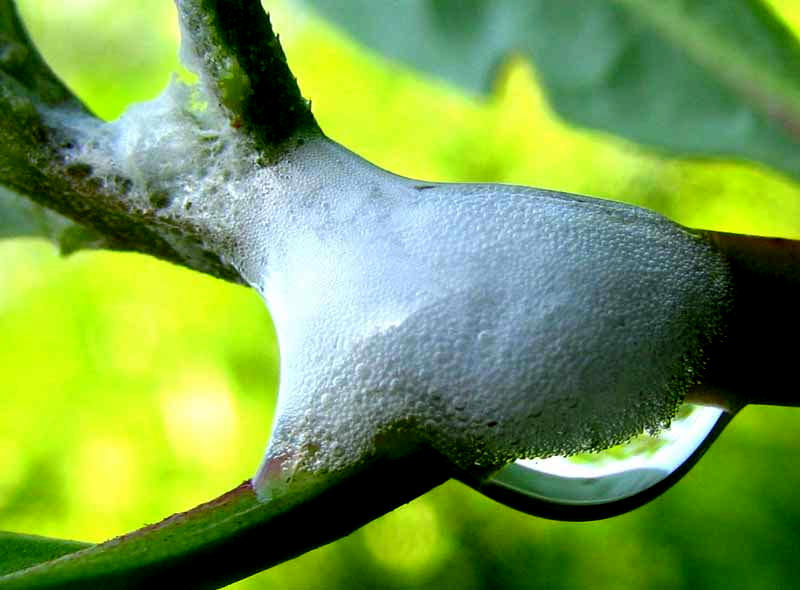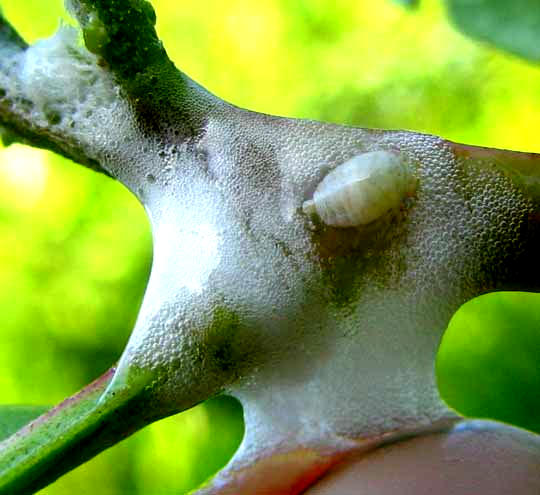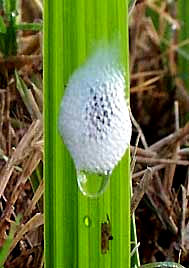Excerpts from Jim Conrad's
Naturalist Newsletter

from the October 30, 2011 Newsletter issued from Mayan Beach Garden Inn 20 kms north of Mahahual, Quintana Roo, México
SPITTLEBUGS
You don't think of Buttonwood mangrove as being particularly buggy, but nowadays a good number of them have spittlebugs on their outer, younger branches. You can see a spittlebug's surprisingly pretty spittlebug above.
If you're familiar with spittlebugs you know you can poke your finger at the spittle, the spittle will stick to your finger, and when you withdraw the finger the spittle will collapse and sometimes you can see the "bug" creating the spittle. All this is shown below:

That egglike thing with a nipple at one end is the spittle-producing "bug." It's the larva of a kind of insect whose adult form is known as a froghopper. Froghoppers belong to the True Bug Family, the Hemiptera, so spittlebugs and froghoppers are real bugs, along with cicadas, aphids, planthoppers, leafhoppers, and shield bugs.
So, why does that little egg-shaped larva spew spit around itself? You can see that the bubbly stuff effectively hides the larva from predators, though in Mississippi I've seen Orchard Orioles and Red-bellied Woodpeckers probe spittlebug spittle on pine trees, apparently looking for and capturing the larvae, to eat.
Experts, though, often emphasize other advantages to living inside a gob of spit. The foam effectively insulates the larva from surrounding temperature and humidity extremes.
from the September 21, 2007 Newsletter issued from Sierra Gorda Biosphere Reserve, QUERÉTARO, MÉXICO
SPITTLEBUGS
 During recent days we've had several nights of rain, then the next morning sunbeams would slant in from over the eastern mountains lighting up grassblades tipped with water droplet and acacia leaflets shiny and bejeweled. On many grassblades also there have been spittlebugs enshrouded with white foam, as you can see at the right.
During recent days we've had several nights of rain, then the next morning sunbeams would slant in from over the eastern mountains lighting up grassblades tipped with water droplet and acacia leaflets shiny and bejeweled. On many grassblades also there have been spittlebugs enshrouded with white foam, as you can see at the right.
Folks here call the white, spittle-like blobs angelitos, which means "little angels," and that makes sense when you see the glowing, white globules held aloft on their grassblades.
Despite gracing spittlebug spit-blobs with such a benign name, Don Gonzalo also calls them a plaga, a sort of plague on the plants they appear on. For, inside each cluster of bubbles there's an immature insect, a nymph, with a slender, strawlike proboscis inserted into the plant's conducting tissue, robbing the plant of its juices. In the above picture you can barely make out something dark in the blob's center, and that's the nymph.
Insect nymphs constitute the middle stage of incomplete insect metamorphosis. Remember that the stages of complete metamorphosis undergone by such insects as butterflies and moths are:
EGG >> LARVA >> PUPA >> ADULT
The stages of incomplete metamorphosis are:
EGG >> NYMPH >> ADULT
Insect nymphs are similar to adults, except that they're smaller, have no wings or their wings aren't yet fully developed, and the nymph usually has a paler color than the adult.
That's the way it is with spittlebug nymphs. They look a lot like their adult stages, except that they're smaller, wingless, and paler. Several photos of spittlebugs in their nymphal and adult forms are shown at https://bugguide.net/node/view/145/bgimage.
The adults are often called froghoppers because their blunt heads have goggly eyes, and they are very powerful hoppers. They're closely related to cicadas and aphids. Other insect groups with incomplete metamorphosis, and therefore with nymphal stages, include dragonflies, grasshoppers, "true bugs" such as stinkbugs, and termites and earwigs.
from the May 9, 2004 Newsletter issued from the woods near Natchez, Mississippi, USA
EATING SPITTLEBUGS
Last week a very conspicuous feature around my trailer was that the too-closely growing, young Loblolly Pines were heavily infested with spittlebugs. Spittlebugs are the nymphs, or immature stage, of an insect called the froghopper. Spittlebugs are soft-bodied creatures who avoid their predators by creating around themselves a white, frothy mass of bubbles that looks very much like a gob of soapsuds maybe an inch across. Hundreds of such masses showed up very well along the dark wall formed by the pines around my trailer.
Today I don't see a single spittlebug mass remaining around the barn. However, walk about ten minutes away and the masses begin appearing again, just as numerous as they were here last week. It sure looks like the orioles and woodpeckers have cleaned the spittlebugs from around the barn.